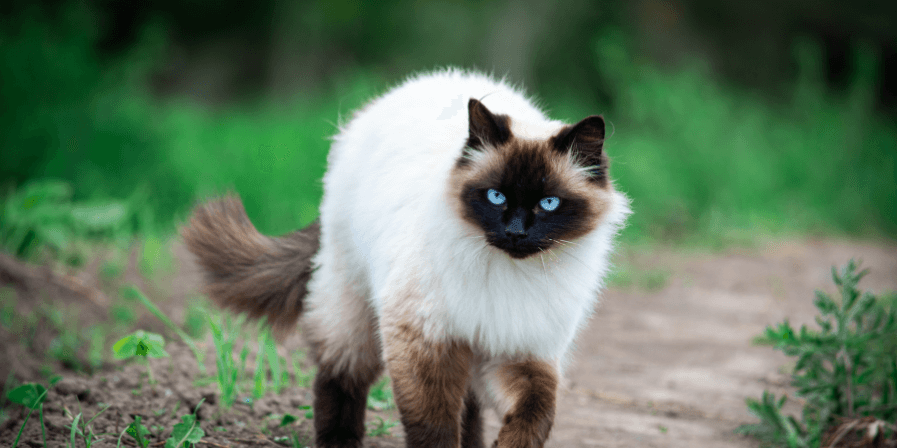Himalayan Cat

The Himalayan cat—often called the "Himmy" by admirers—is a graceful blend of two beloved breeds: the elegant Persian and the color-pointed Siamese. With its luxurious long fur, striking blue eyes, and calm, affectionate temperament, the Himalayan is a popular choice for cat lovers who want a companion that is as beautiful as it is loving.
Caring for a Himalayan cat means embracing both its beauty and its high-maintenance needs. From daily grooming rituals to paying close attention to health and diet, the Himalayan thrives in an environment where it receives gentle care and lots of attention. Whether you're planning to adopt one or already share your home with this majestic feline, here’s everything you need to know to help your Himalayan cat lead a healthy, happy life.
General Care for Himalayan Cats
Himalayans are indoor cats by nature—and necessity. Their long, dense coats are prone to matting, and they are not built for outdoor dangers like dirt, weather, or predators. They enjoy lounging around the house, curling up in cozy spots, and observing the world from sunny windowsills. But don’t let their calm demeanor fool you—Himalayans enjoy bursts of play and are especially fond of toys they can bat around or chase.
Because they are generally quiet and reserved, they do well in peaceful households. They bond deeply with their families and often form particularly close attachments to one or two people. While they tolerate children and other pets, they prefer a calm, gentle approach and may retreat if things get too loud or chaotic.
Routine is essential to a Himalayan cat’s happiness. They enjoy knowing what to expect and can become stressed with frequent changes in environment or schedule. Create a stable, serene environment, and your Himalayan will flourish.
Health Considerations Like their Persian ancestors, Himalayan cats are brachycephalic, meaning they have flat faces and short noses. This unique facial structure gives them their signature sweet expression, but it also predisposes them to certain health concerns. Responsible care involves being proactive and aware of the issues commonly seen in the breed.
-
Respiratory Issues - The flat face that makes them so distinctive also means narrow nasal passages and a higher risk of breathing difficulties. You might notice snorting, noisy breathing, or snoring. Keep your Himalayan in a cool, dust-free environment and avoid excessive physical stress that can affect their breathing.
-
Polycystic Kidney Disease (PKD) - PKD is a hereditary condition that can affect Himalayan cats, causing fluid-filled cysts to form in the kidneys. Reputable breeders screen for this condition, but if you’ve adopted your Himalayan, regular vet checkups and ultrasounds can help monitor kidney health.
3.** Dental Disease** - Small jaws and crowded teeth make Himalayans prone to dental problems. Without regular brushing and dental care, plaque and tartar build-up can lead to painful infections or tooth loss.
**4. Eye Issues **- Tear staining, excessive discharge, and blocked tear ducts are common due to the shape of their face. This requires regular cleaning and monitoring for signs of discomfort or infection.
With routine veterinary care, including dental check-ups and early screening for inherited conditions, your Himalayan cat can enjoy a long and comfortable life. Their average lifespan is between 12–15 years, and many live even longer with proper care.
Feeding Guide
Himalayans are not overly active cats, so weight management is key. They’re content with lounging but do have moments of playful energy, especially when encouraged by interactive toys or wand games. Because of their low activity level, they’re at risk for obesity if overfed or given too many treats.
A balanced diet tailored to their size and lifestyle is essential. Choose a high-quality commercial cat food that lists protein—such as chicken or fish—as the first ingredient. Avoid foods loaded with fillers, artificial preservatives, or by-products.
Portion control is important. Feed your Himalayan measured meals twice a day instead of free-feeding, which can lead to weight gain. You can also consider breed-specific food designed for Persians or flat-faced cats, which are formulated to support oral health and ease of eating.
Always ensure fresh, clean water is available. Adding a cat fountain can encourage hydration, which is especially beneficial for kidney and urinary tract health.
Behavior and Training
Himalayan cats are gentle, affectionate, and intelligent—but they are also known for being a bit on the quiet side. They may not be as vocal as their Siamese relatives, but they will still "talk" to you in soft, sweet meows, especially when they want attention.
They are creatures of comfort and habit. They appreciate peaceful routines and don't require a lot of excitement. However, mental stimulation is still important. Puzzle toys, feather wands, and interactive play sessions are great ways to keep them engaged. Some Himalayans even enjoy learning tricks or using a litter box with a lid for a little extra privacy.
Training a Himalayan cat doesn’t require heavy-handed tactics. They respond best to soft voices and rewards like treats or affection. Negative reinforcement can stress them out or cause them to withdraw. Litter box training usually comes naturally, but cleanliness is crucial—these cats are quite particular about hygiene.
Grooming
The Himalayan’s crowning glory is its long, thick coat. But with beauty comes responsibility. Grooming is perhaps the most time-consuming part of caring for this breed—and it's not optional.
Daily brushing is recommended to prevent tangles and mats, especially around the neck, chest, and hindquarters where knots form easily. Use a wide-tooth comb for detangling and a slicker brush to keep the coat smooth and fluffy. If brushing becomes neglected, the fur can mat severely, causing discomfort or skin infections.
Bathing once a month can help keep the coat clean and reduce oil buildup, especially in cats prone to greasy fur. Make sure to dry the coat completely afterward, as dampness can cause chills or promote fungal infections.
Regular nail trimming and paw checks are also important, especially since Himalayans may not wear down their nails naturally if they’re mostly indoors.
Eye & Ear Care
Because of their facial structure, Himalayans are prone to tear staining and eye discharge. You might notice reddish-brown stains around their eyes—especially in lighter-colored cats. Wipe their eyes daily using a soft cloth or pet-safe wipe to keep the area clean. Be gentle and avoid using human skincare products.
Their ears also need routine care. Due to their thick fur, Himalayans can trap debris or wax in their ears, which may lead to infection. Check weekly for any signs of odor, redness, or buildup, and clean the ears with a vet-recommended solution if needed.
Conclusion
Himalayan cats are truly regal companions—quiet, sweet-natured, and undeniably beautiful. But beneath that plush coat and soulful gaze is a cat that depends on you for more than just admiration. They require attentive grooming, regular veterinary care, a calm environment, and plenty of love to thrive.
Whether they’re nestled in your lap during a quiet evening or patiently waiting by the window, Himalayans offer a serene kind of companionship that cat lovers deeply appreciate. And while their luxurious looks demand a bit more effort, the bond you’ll form with a Himalayan cat is well worth the commitment.
At DCC Animal Hospital, we’re here to help you keep your Himalayan healthy, happy, and looking their best. From grooming advice to complete health check-ups, our team is dedicated to the well-being of your feline companion.
FAQs
1. Are Himalayan cats hypoallergenic?
No, Himalayan cats are not hypoallergenic. They have a long coat that sheds and produces dander, which can trigger allergies in sensitive individuals. Regular grooming and vacuuming can help reduce allergens in the home.
2. Do Himalayan cats get along with other pets?
Yes, they typically do well with other calm pets. They’re gentle and non-confrontational, making them good companions for other cats or dogs that share a relaxed temperament. Proper introductions are important to ensure harmony in a multi-pet household.


 How can we help?
How can we help?